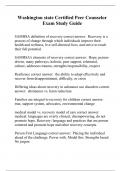Washington state Certified Peer Counselor
Exam Study Guide
SAMHSA definition of recovery correct answer: Recovery is a process of change through which individuals improve their health and wellness, live self-directed lives, and strive to reach their full potential.
SAMHSA's elements of recovery correct answer: Hope, person-
driven, many pathways, holistic, peer support, relational, culture, addresses trauma, strengths/responsibility, respect
Resiliency correct answer: the ability to adapt effectively and recover from disappointment, difficulty, or crisis
Differing ideas about recovery in substance use disorders correct
answer: abstinence vs. harm reduction
Families are integral to recovery for children correct answer: true, support system, advocates, environmental change
medical model vs. recovery model of care correct answer: medical: languages are overly clinical, disempowering, do not promote hope. Recovery: language and practices that are person centered and promote hope and other recovery concepts
Person First Language correct answer: Placing the individual ahead of the challenge. Power with. Model this. Strengths based.
No jargon. Two ways peer supporters support recovery correct answer: Inspire hope and possibility. Support peers to get in touch with their own inner wisdom. Working with, not giving to, not doing for. Not sage on the stage but guide on the side. share your own story of hope and overcoming challenges, support choice and empowerment, encourage opportunities for additional support
hope is essential for recovery correct answer: the turning point when we start to have the smallest belief that our lives can improve. The belief that a positive outcome or better situation lies ahead.
Peer partner skills correct answer: listen actively, support engagement, ask recovery supported questions. SOLER, seat towards peer, open posture, lean toward peer, eye contact, relax
Listen to meaning, feeling, values correct answer: quietly without judgement, lean in with curiosity, check your bias and your story, pay attention to feeling and nonverbal cues
Demonstrating understanding correct answer: paraphrasing, reflecting feeling, responding to meaning
Orienting correct answer: what's going to happen, why (what's in it for peer, why do it), how the process happens
types of questions correct answer: open ended, direct, clarifying
Recovery story correct answer: focus on hope, share only when relevant, ask permission, just the salt and pepper




